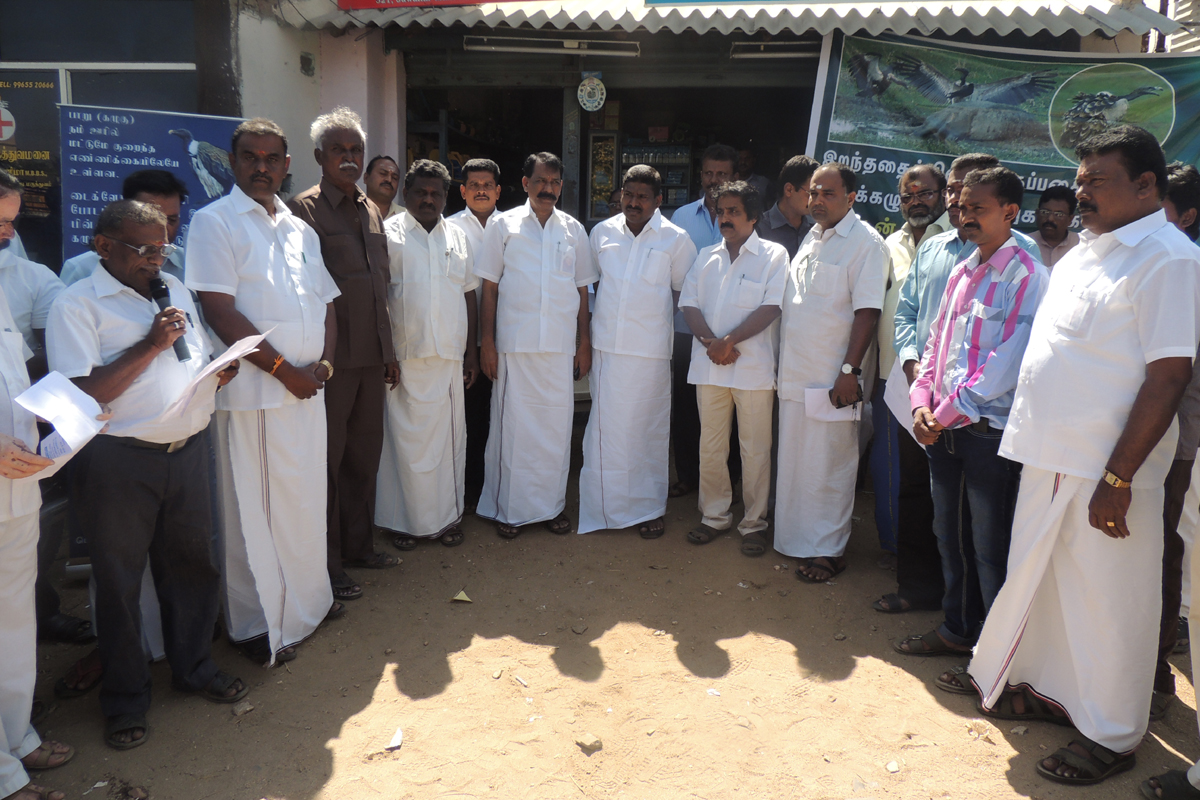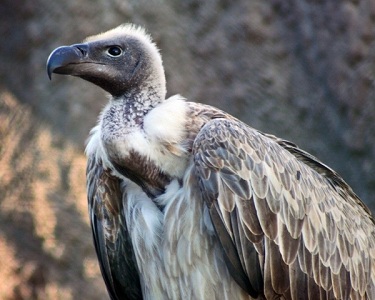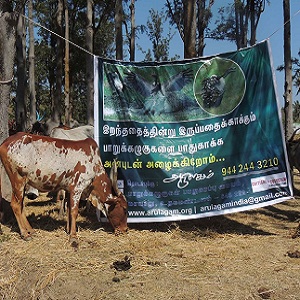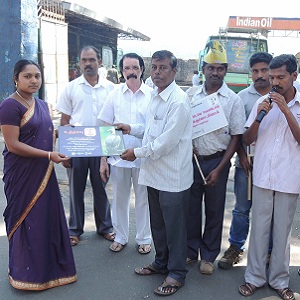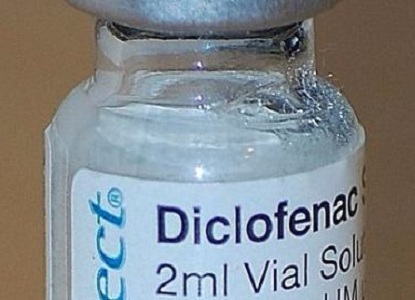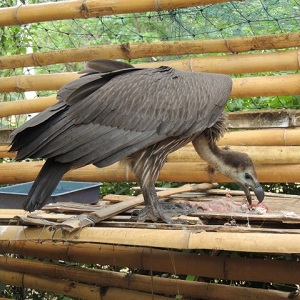Human Chain rally @Punsai Puliampatty
Human Chain Rally @Punsai Puliampatty Against Diclofenac
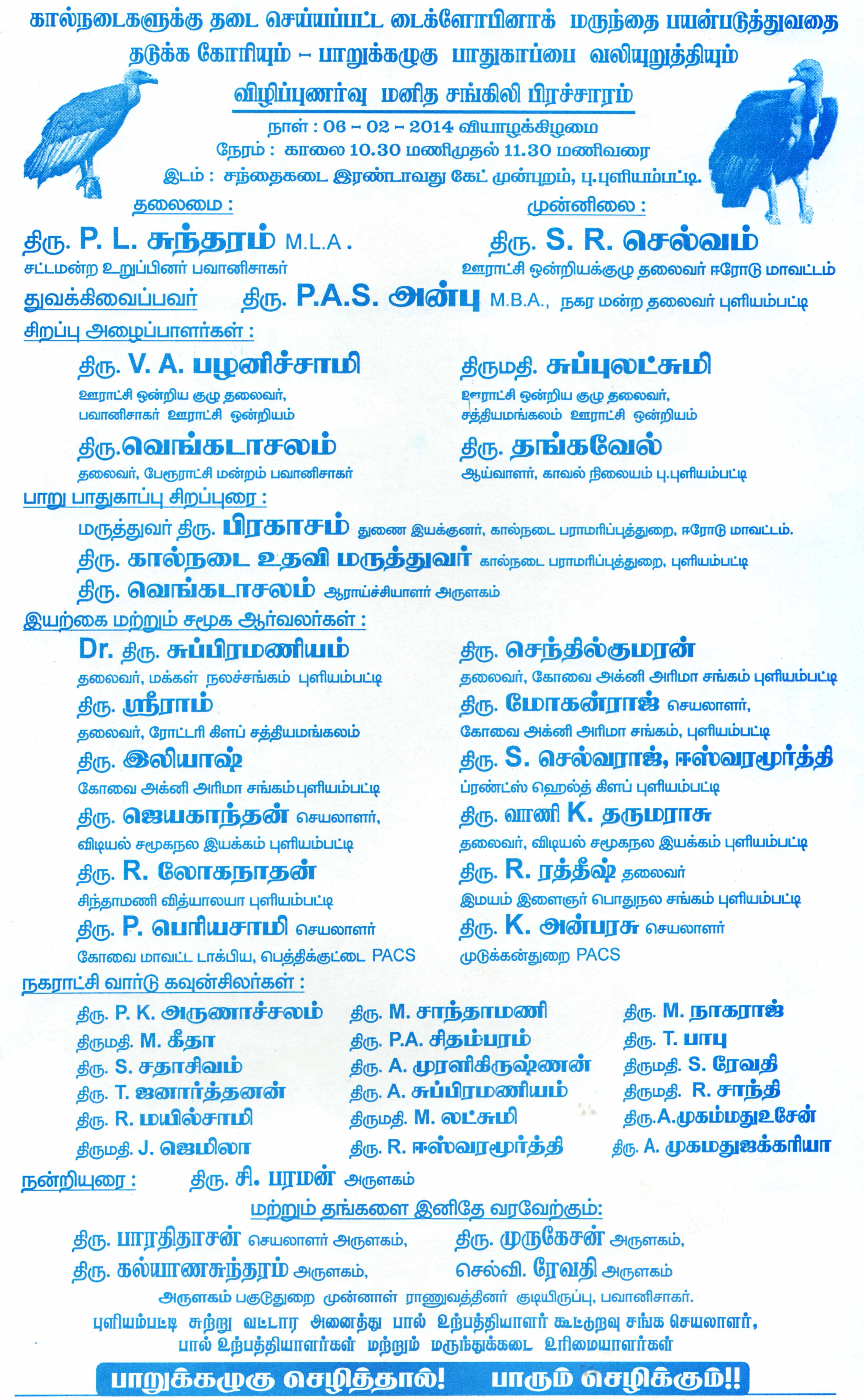
Date : 06th Feb,2014 Place : Puliampatti Market Time : 10.30 - 11.30 AM
Arulagam with the support of CEPF and in co-ordination with TamilNadu Forest Department is working towards the conservation of Vultures. As part of the ongoing conservation work, human chain rally against the use of Diclofenac,a banned drug for Cattle happened at Puliampatti. Accepting our invitation, Bhavani sagar MLA Mr.P.L.Sundharam presided over the function while Mr.P.A.S.Anbu, Punsai puliampatti President inaugurated the function. Mr.P.Selvam, District Panchayat Head,Erode also participated in the function. Various environmentalists and nature lovers participated in the event.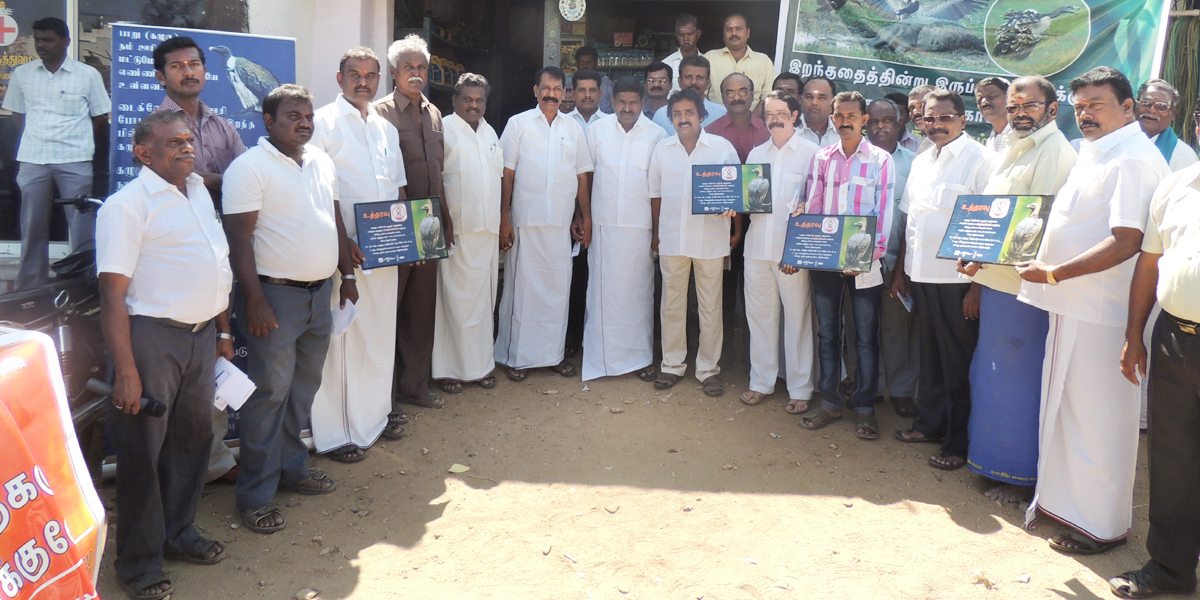
Synchronized Vulture Survey - Feb 2014
In co-ordination with Tamil Nadu Forest Department, Arulagam organized Synchronized Vulture Survey in Nilgiri North Forest Division and Sathyamangalam Tiger Reserve on 21st, 22nd & 23rd Feb'14.
About 30 bird watchers volunteered their time and participated in the survey, The synchronized survey was carried out using Vantage Point survey method. Eleven Vantage Points were selected in Sathamangalam Tiger Reserve and nine in Nilgiri North Forest Division for this purpose. The occurrence of the vultures in different habitats were recorded.
Burgur Cattle Show
Burgur Semmarai breed cattle show and Vulture conservation propaganda
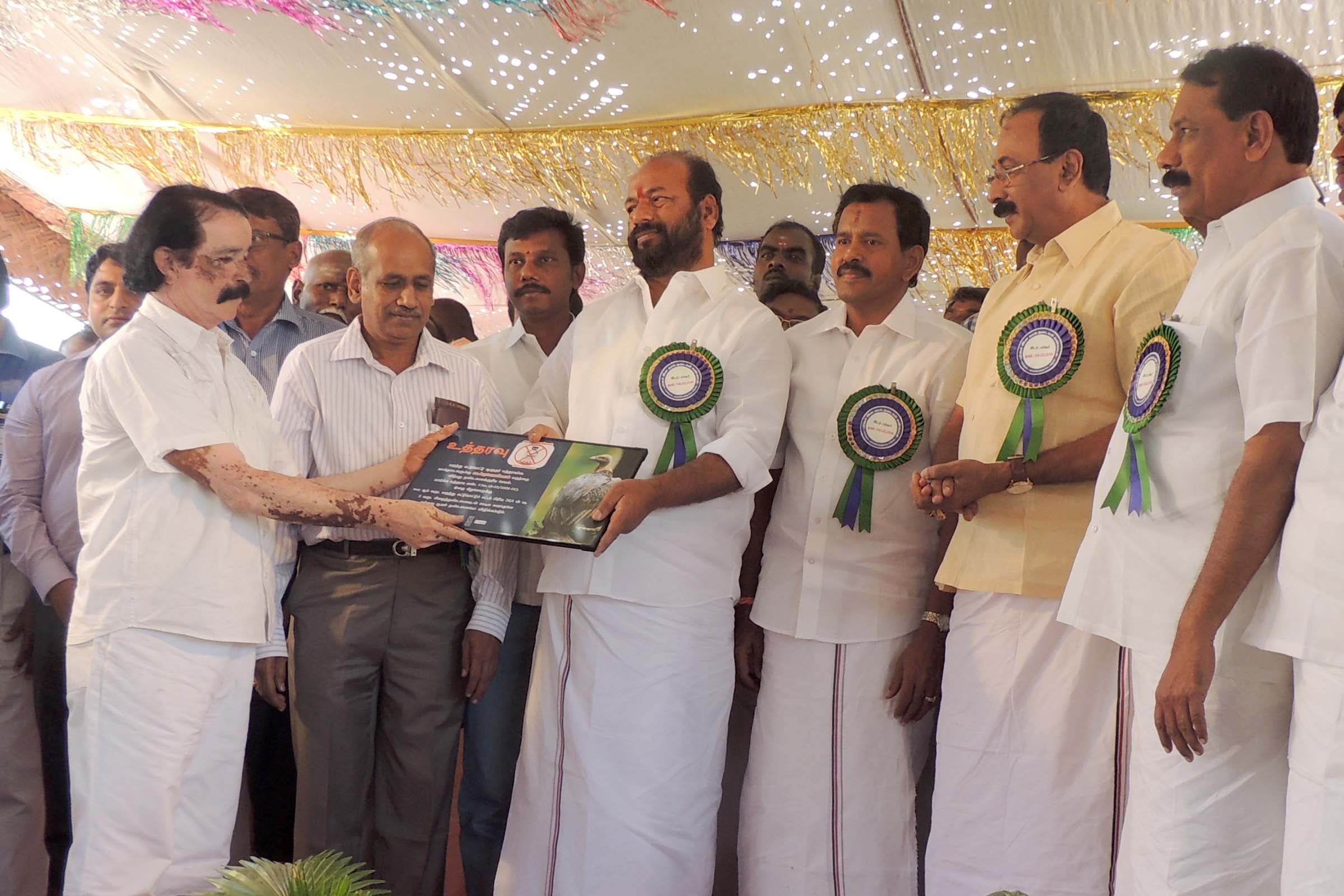
Place: Thurusanampalayam Date: 08-02-2014 Time: 10.30AM
Gudalur Human Chain Rally
Human chain for Establishing Vulture safe zone conducted at Gudalur on 30 Dec'13
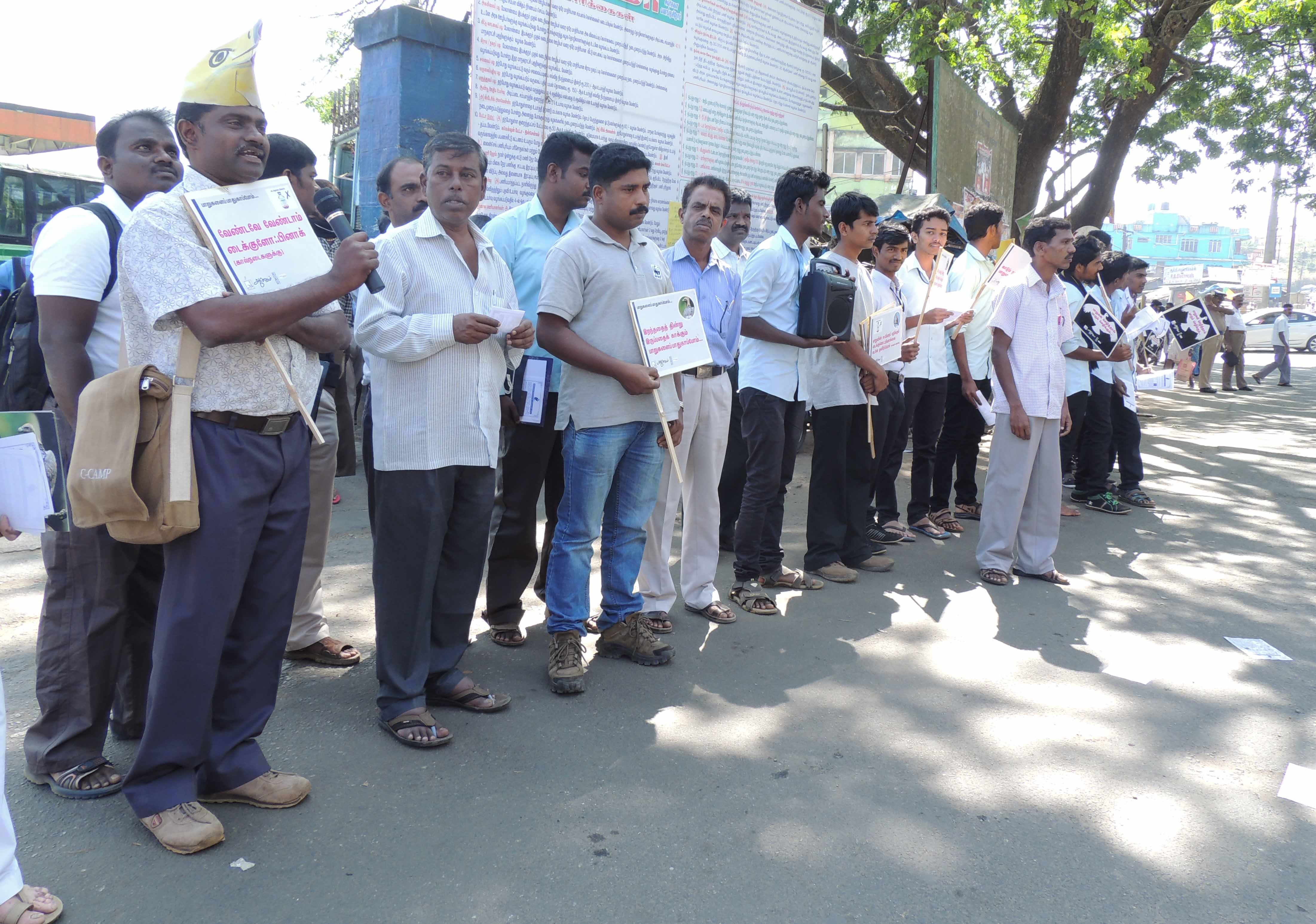
Venue: Bus Stand, Gudalur, Nilgiri District
Organisers: Arulagam and Tamil Nadu Forest Department
Target group: Veterinarians, Pharmacy owners, Cattle growers and public
Purpose: To spread awareness about endangered vultures and threat to vulture populations because of Diclofenac drug.
Medium: Human chain, Personal interaction and printed materials.
Funding / Collaboration: CEPF
As a part of the diclofenac free campaign, today 30/12/2013, Vulture conservation awareness cum Human chain was organized by Arulagam in Gudalur bus terminal, Udagamandalam. The human chain rally was inaugurated by the people representative Mrs. G. Ramamani, Chairman, Gudalur Municipality. Mr.Tejaswi, IFS, DFO Gudalur, Mrs.Indurani, Chairman, Panchayat Union, Gudalur, Mr. S.K. Lachiyathambiduarai, BDO, Gudalur, Vulture brigade members from Anaikatty & Siriur village and Volunteers from Bharathiar University Arts & Science college also participated. Mr. S. Bharathdasan, Secretary, Arulagam lead the rally and appealed to Veterinarians, Pharmacy owners, Cattle growers, and the public to join hands to establish a vulture safe zone by eliminating Diclofenac for cattle usage.
Dr. S. Srinivasan, Additional Director, Animal Husbandry said that Govt of India banned Diclofenac for cattle usage in 2006 and we use only Meloxicam, an alternate safe drug. He also reiterated that it is illegal and unethical for any vets or pharmacy shops selling and injecting human diclofenac to cattle. Moreover, it's an offense and the Government has the right to withdraw their License and they will get maximum imprisonment.
Mr.Boominathan, Coordinator, WWF-India spoke about the vultures in Moyar Valley and their importance in the landscape. He also insisted carcasses poisoning also could be a reason for vulture declining in the landscape.
Shun diclofenac awareness poster was handed over to Dr.S. Srinivasan, Additional Director, Animal Husbandry Department, Gudalur. Since Gudalur holds multi linguistic people like Malayalam, Tamil, Kannada and also indigenous people such as Irulas, Betta krumba and Kattu Naickar the awareness spread in all those languages. Message in English sent by Mr. Chris Bowden, Programme Manager, Saving Asia’s Vulture from Extinction was also read on that occasion. Representative from Kattunaika community Mr. Marigan, Betta gurumba community Mr. Suresh, Irula community Mr. Mari, Baduga community Mr.Sundararajan and Malayali community Mr. Sugumar also took part in this rally.
During this programme slogans were raised for vulture conservation. Awareness posters and banners on diclofenac were displayed. Vulture cap adorned by the participants attracted the viewers. Posters and bit notices on vultures distributed to the public including pharmacy owners. The event was organised by Arulagam team Venkitachalam, Paraman , Murgesan , Vulture brigade members & volunteers.
This programme got wide public attention rather than hall meeting. So, we have planned to repeat this in a small town in coming months.
Drug Controller Raid
Drug Inspectors investigate reports of human painkillers being used for cattle
The State Drug Control Department is investigating reports of a painkiller meant for human use being diverted for veterinary purposes in the hilly areas of Western Tamil Nadu. It may be recalled that the particular painkiller meant for cattle had already been banned, as the remains of the drug in the carcass of cattle endangered the lives of vultures. Pharmacies located in Gudalur, Thalavadi, and Sathyamangalam, besides Sirumugai, Mettupalayam and Annur, have been put under surveillance following reports of Diclofenac Sodium being sold for use for treating sick cattle.
White-backed vulture chick rescue, rehabilitation and release
Written by S. Bharathidasan and Mrs. Vaidehi Herbert
On September 7, the International Vulture Awareness Day aimed to bring awareness to vulture conservation activities and the threats that some species are facing. Here S. Bharathidasan from Arulagam, an NGO working towards the conservation of fauna and flora in Tamil Nadu, India, writes about his recent experience saving a white-backed vulture chick.
A robust scavenger, the Critically Endangered white-backed vulture (Gyps bengalensis) was once described as “possibly the most abundant large bird of prey in the world.” But an extremely rapid population decline (more than 99 percent) resulted from the birds ingesting the carcasses of animals treated with Diclofenac, an anti-inflammatory drug used to treat domestic livestock.
With the support of CEPF through its investment in the Western Ghats Region of India, Arulagam and Saving Asia’s Vulture from Extinction (SAVE) have devised a plan for a vulture safe zone – an area around Moyar Valley in India with a radius of up to 100 kilometers where vultures can find food that is diclofenac free.
Earlier this year, while searching for vultures with the Arulagam vulture research team near Thalamalai, India, a vulture chick that had fallen from its nest was discovered by vulture volunteers in Siriur. Unable to fly, the chick needed rescuing immediately. Although rushing to Siriur meant that I had to put off finishing a report due to the Ministry of Environment and Forest, the vulture chick rescue was the most important matter to me.
When we reached Masinakudi, a 3.5-hour car ride away from where we were, I bought glucose water and goat meat for the vulture chick, which was sent with the team. I had completed my report during the car ride, so I went to email the report, and then catch a bus to join the rescue team in Siriur. By the time I reached the team that night, the chick had been taken to the forest guards’ quarters. We worked with the forest department staff to cut bamboo, stripping its leaves, to make a nest for the chick. We then checked the chick for wounds and bruises, checked its stool and weighed the bird. Luckily, everything seemed to be okay. Because the chick weighed only 2.7 kilograms (approximately 6 pounds), we estimated it to be around 90 days old and determined that its wings were not fully grown.
Before this, I had only seen vulture chicks through binoculars. It was absolutely delightful to see the chick now in such close quarters. In rescue situations, it is traditional to make a fake bird that looks like an adult vulture and feed food to the chick through its beak. There are two benefits to this method: the chick will eat without fear or shyness, and unnecessary contact with humans can be avoided so they can survive when released and not be dependent on humans. We were unable to do that in this case, so I held the chick and attempted to feed it pieces of chopped up goat meat that were soaked in glucose water.
The next day Dr. Manoharan, a wildlife veterinarian, came and confirmed that the chick was healthy. He praised our rescue efforts and suggested that we feed the chick different kinds of meat, instead of the same kind every day. I then got in touch with veterinarian Jeganmohan, a friend of Arulagam, who suggested the homeopathy medicine Aconyte for the chick to help reduce the shock effects from falling from its nest. He sent this by courier service and we mixed it in glucose water and added it to the meat that we fed the chick.
After considering the targeted weight for the chick, we decided that we needed to feed it 600 grams (approximately 1.3 pounds) of meat a day, which we split into two meals. Since using Diclofenac for cattle has not stopped completely, we decided to feed the chick only goat or pig meat. However, this was not so simple, due to the cost of goat meat and because we had to travel 27 kilometers to Masinakudi by bus. We struggled since the bus left in the morning and returned only in the evening.
Having no refrigerator also presented problems. If we bought meat and left it out, it would become rotten or it might draw the attention of meat-eating wild animals. Nobody around had a refrigerator either, so even though it was expensive, we brought one from the Arulagam office. A family in the village happily offered their house to place the refrigerator.
We appointed a vulture watcher to protect and feed the chick. We also asked to be informed if any cattle in town died naturally or were killed by a tiger, but the local culture did not allow us to feed a dead cow’s meat to the chick. We then arranged for a meat shop owner to send meat once every three days.
Within two days, the chick started to eat on its own. In 18 days, it started to hold meat pieces with its feet and tear them apart, so we threw larger pieces into its cage. Once the chick weighed 3.1 kilograms (approximately 7 pounds), we increased the food to one kilogram (approximately 2 pounds) a day. We avoided human contact as much as we could, since we didn’t want the chick to start relying on people for food.
The chick needed a larger space to spread its wings and learn to fly. To build a bigger cage nearby, the vulture brigades volunteers who spread the word about vulture conservation and the dangers of Diclofenac – and volleyball players from Anaikatti and Siriyur joined us to place bamboo crossbars together. We used old volleyball nets to protect the cage.
We gently moved the chick to the new cage, where it spread and turned its wings in happiness. Since the chick was too young for us to determine its sex, we tagged it with an identification ring that the Bombay Natural History Society provided. This would allow us to easily identify the chick once released and determine its sex once it has matured.
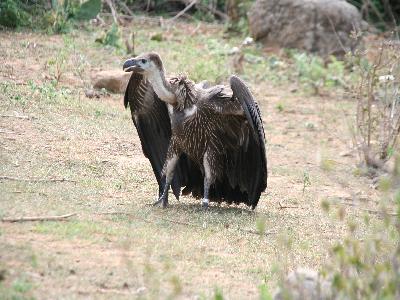
After 85 days, the chick was released. It was a memorable event for all of us. Initially the bird struggled, but then it slowly gained the ability to fly, and settled on a nearby tree. For four days the chick remained on the tree without eating, and on the fifth day it circled the sky and moved into the forest. Our team is now trying to track the chick.
This rescue was a new experience for Arulagam and me. We were totally involved with the chick for three months and it gave us a lot of mental satisfaction. Since only a little more than 100 white-backed vultures live in the Moyar region in southern India, every effort must be made to protect them. By rescuing this chick, we were helping ensure the survival of the species. We were not worried about victory or failure, nor did we calculate the money spent. We looked at this chick as a member of the continuous life chain and trusted that from this one, a thousand will come.
This was a group effort and I want to offer sincere thanks to the following people for their support and encouragement during the rescue period:Mr.Sukirtharaj Kovilpillai, district forest officer, Nilgiri North; Mr. Sivamani,assistant conservator of forest; Mr.R. Chellathurai, ranger, Siriyur; Mr.Sivakumar, Forester, ornithlogists Dr. Ranjit.Daniels(Care Earth Trust), Mr.C.Sasikumar (Malabar Natural History Society) and Dr. Raja Jeyapal (Salimali Center for Ornithology and Natural History); Mr.Mohanraj and Mr. Boominathan of World Wide Fund for Nature- India; Mr.Lokesh Kalyanasundaram (Coimbatore); Mr.M.Lenin Family; Mr.Balaji (Velicham); Mr.Amsa(Thiruppur); Mr.Melkis Raja; Mr. Raghunath (Artist); Arulagam team Mr.Venkatachalam; Mr.Anup; Ms.Revathi; Anaikkatti and Siriyur volleyball players; miva (for sponsoring transportation); Forest staff Mr.Rajagopal, Mr.B.Jaiganesh, Mr.R.Kannan, Mr.Prakash, Mr. Gunasekar and all the other forest staff who helped us; Our Special thanks to Mr.Pasavan (plot watcher) and Karthi (Volunteer).
S. Bharathidasan, secretary of Arulagam, is the project leader of the CEPF-funded project “Right to Soar High Again: Establishing a Vulture Safe Zone in Southern India,” which aims to establish a vulture safe zone in the Mysore-Nilgiri-Sathyamangalam landscape, where no veterinary drugs harmful to vultures are present in cattle carcasses. Arulagam will develop targeted awareness raising and community engagement activities for the vulture safe zone, and undertake participatory research to evolve a long-term strategy for vulture conservation.
Special Thanks to Mrs.Vaidehi herbert for translating this article from Tamil to English
Vulture Awareness Program at Anaikatty School
Date: September 22, 2012
Venue: Primary School, Anakatty Tribal Village, Nilgiri District
Organisers: Arulagam, Tamil Nadu Forest Department and District Education Department
Target group: Tribal primary school students and teachers
Purpose: To spread awareness about endangered vultures and threat to vulture populations because of Diclofenac drug.
Medium: Personal interaction and printed materials.
Funding / Collaboration: CEPF
Vulture Awareness Program at Ayyampalayam
Date: August 17, 2012
Venue: Ayyampalayam Village, Coimbatore
Organisers: Arulagam and NSS of Nirmala College for Women
Target group: Local villagers owning cattle, Students and Nature lovers
Purpose: To spread awareness about endangered vultures and threat to vulture populations because of Diclofenac drug.
Medium: Human chain rally, play acting, personal interaction and printed materials.
Funding / Collaboration: CEPF
Vulture Conservation Campaign at Masinagudi
Date: August 16, 2012
Venue: Masinagudi Village, Nilgiri District
Organisers: Arulagam, Tamil Nadu Forest Department and District Education Department
Target group: Local students and teachers and Nature lovers of Masinagudi
Purpose: To spread awareness about endangered vultures and threat to vulture populations because of Diclofenac drug.
Medium: Human chain rally, personal interaction and printed materials.
Funding / Collaboration: CEPF
Page 7 of 13


